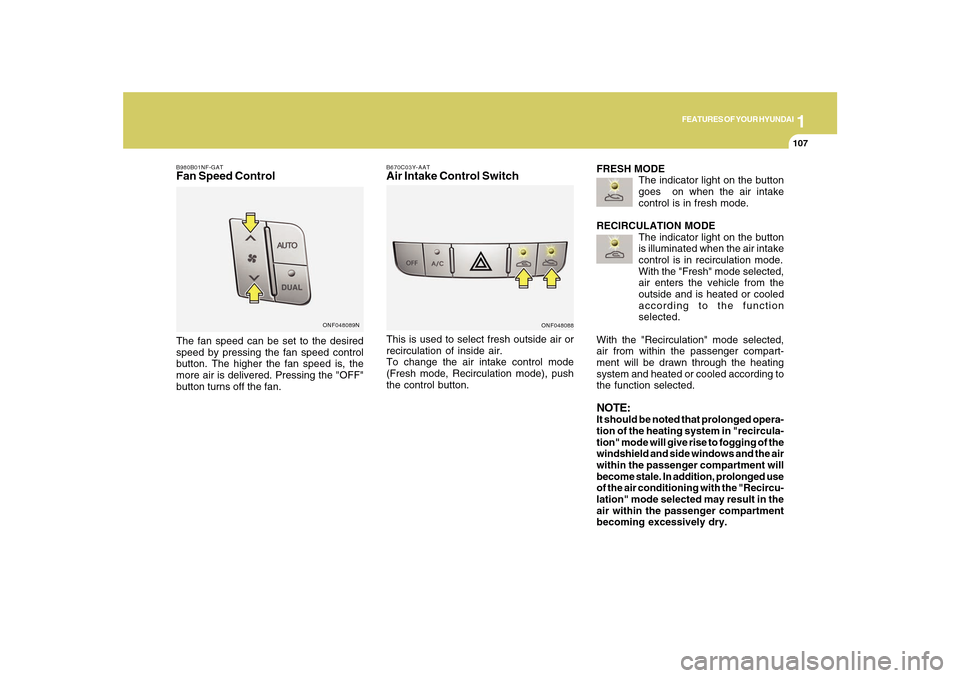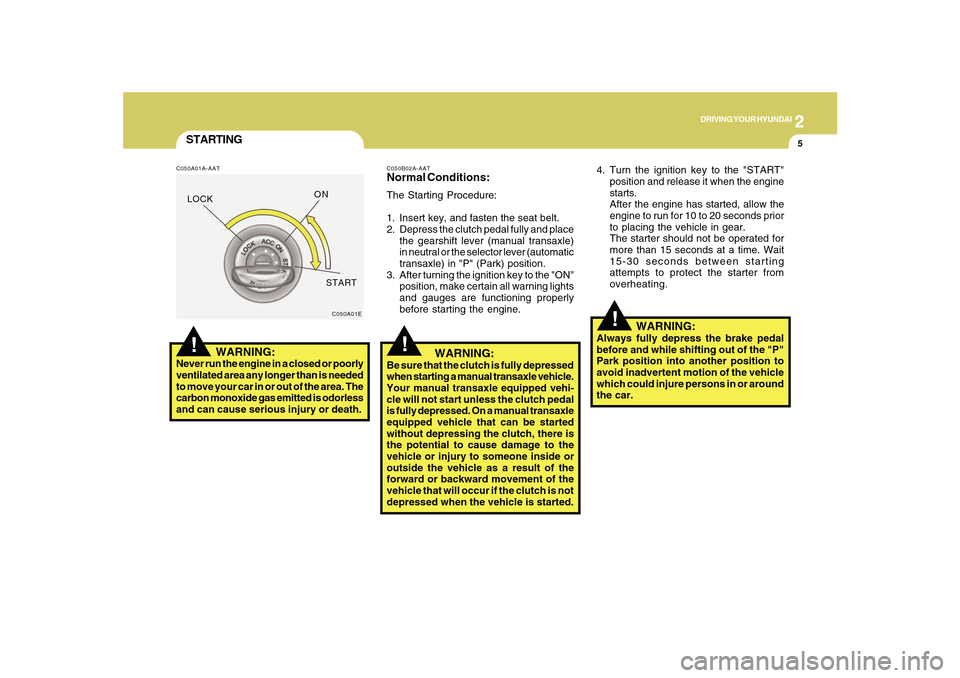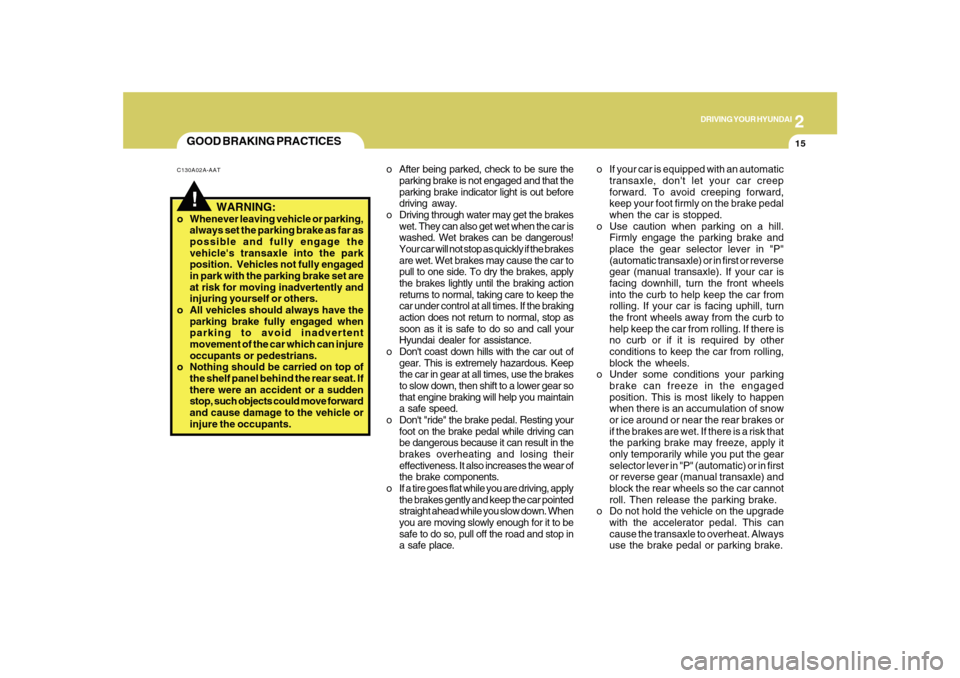2010 Hyundai Sonata heating
[x] Cancel search: heatingPage 116 of 285

1
FEATURES OF YOUR HYUNDAI
103103
ONF048093 ONF048095N
DEFROSTING/DEFOGGINGB720A02E-AATUse the heating/ventilation system to defrost or defog the
windshield:
To remove interior fog on the windshield;
o Set the fan speed control between "1" and "4" position.
o Set the temperature control to the desired position.
o Set the air flow control to the defrost ( ) position. (The
A/C will turn on automatically and the "Fresh" mode will be
activated.)To remove frost or exterior fog on the windshield;
o Set the fan speed control to position "3" or "4".
o Set the temperature control to warm.
o Set the air flow control to the defrost ( ) position. (The
A/C will turn on automatically and the "Fresh" mode will be
activated.)
NOTE:When the A/C is operated continuously on the floor-defrost level ( ) or defrost level ( ), it may cause fog to form on the exterior
windshield. If this occurs, set the air flow control to the face level position ( ) and fan speed control to the low position.
ONF048092
Manual A/C Automatic A/C
Manual A/C
Automatic A/C
ONF048094N
Page 117 of 285

1FEATURES OF YOUR HYUNDAI
104
AUTOMATIC HEATING AND COOLING CONTROL SYSTEMB970A01Y-AAT(If lnstalled)Your Hyundai is equipped with an auto-
matic heating and cooling control system
controlled by simply setting the desired
temperature.
B970B01NF-AATHeating and Cooling Controls1. Driver's temperature control button
2. Fan speed control button
3. AUTO (automatic control) button
4. Dual temperature control selection but-
ton
5. OFF button
6. Air conditioning button7. Air intake control button
8. Front wiper defrost button
9. Rear window defrost button
10. Mode selection button
11. Passenger's temperature control but-
ton
12. A/C display
ONF048082L
Page 118 of 285

1
FEATURES OF YOUR HYUNDAI
105105
B970C02NF-AATAutomatic OperationThe FATC (Full Automatic Temperature
Control) system automatically controls
heating and cooling as follows:
1. Push the "AUTO" switch. The indicator
light will illuminate confirming that the
Face, Floor and/or Bi-Level modes as
well as the blower speed and air
conditioner will be controlled
automatically.
And, the air conditioning will operate if
ambient temperature is higher than
35°F(1.5°C) and automatically turns off
if the ambient temperature drops below
33°F(0.6°C).2. Push the "TEMP" button to set the de-
sired temperature.
The temperature will increase to the
maximum "HI" by pushing the up button.
The temperature will decrease to the
minimum "LO" by pushing the down
button.
ONF048083NONF048086
ONF048087
Adjusting the driver and passenger
side temperature individually1. Press the DUAL button to operate the
driver and passenger side temperature
individually. Pressing the right
temperature control button will
automatically switch to the DUAL mode
as well.
2. Press the left temperature control to
adjust the driver side temperature. Press
the right temperature control to adjust
the passenger side temperature.
When the driver side temperature is set to
the highest (HI) or lowest (LO) temperature
setting, the DUAL mode is deactivated for
maximum heating or cooling.
Page 119 of 285

1FEATURES OF YOUR HYUNDAI
106
B980A01Y-AATMANUAL OPERATIONThe heating and cooling system can be
controlled manually as well by pushing
buttons other than the "AUTO" button. In
this state, the system sequentially works
according to the order of buttons selected.
The function of the buttons which are not
selected will be controlled automatically.
Press the "AUTO" button in order to convert
to automatic control of the system.
ONF048115
NOTE:Never place anything over the sensor
which is located on the instrument panel
to ensure better control of the heating
and cooling system.
Adjusting the driver and passenger
side temperature equally1. Press the DUAL button again to
deactivate DUAL mode. The passenger
side temperature will be set to the same
as the driver side temperature.
2. Press the left temperature control button.
The driver and passenger side
temperature will be adjusted equally.Temperature conversionIf the battery has been discharged or dis-
connected, the temperature mode display
will reset to Fahrenheit.
This is normal condition. You can switch
the temperature mode between Fahrenheit
to Centigrade as follows;
While depressing the DUAL button, de-
press the MODE button for 3 seconds or
more. The display will change from Fahr-
enheit to Centigrade, or from Centigrade
to Fahrenheit.
Page 120 of 285

1
FEATURES OF YOUR HYUNDAI
107107
B980B01NF-GATFan Speed ControlThe fan speed can be set to the desired
speed by pressing the fan speed control
button. The higher the fan speed is, the
more air is delivered. Pressing the "OFF"
button turns off the fan.
ONF048089N
B670C03Y-AATAir Intake Control SwitchThis is used to select fresh outside air or
recirculation of inside air.
To change the air intake control mode
(Fresh mode, Recirculation mode), push
the control button.
ONF048088
FRESH MODE
The indicator light on the button
goes on when the air intake
control is in fresh mode.
RECIRCULATION MODE
The indicator light on the button
is illuminated when the air intake
control is in recirculation mode.
With the "Fresh" mode selected,
air enters the vehicle from the
outside and is heated or cooled
according to the function
selected.
With the "Recirculation" mode selected,
air from within the passenger compart-
ment will be drawn through the heating
system and heated or cooled according to
the function selected.NOTE:It should be noted that prolonged opera-
tion of the heating system in "recircula-
tion" mode will give rise to fogging of the
windshield and side windows and the air
within the passenger compartment will
become stale. In addition, prolonged use
of the air conditioning with the "Recircu-
lation" mode selected may result in the
air within the passenger compartment
becoming excessively dry.
Page 121 of 285

1FEATURES OF YOUR HYUNDAI
108
Face-Level (B, D) *
1
When selecting the "Face-Level" mode,
the indicator light will come on, causing air
to be discharged through the face level
vents.
B980D01Y-AATHeating and Cooling System OffPress the "OFF" button to stop the operation
of the heating and cooling system.
ONF048091B980E01NF-GAT
Air Flow ControlThis is used to direct the flow of air. Air can
be directed to the floor, dashboard outlets,
or windshield. Four symbols are used to
represent Face, Bi-Level, Floor, Floor-
Defrost position.
ONF048084N
Floor-Level (C, E, A, D) *
1
When selecting the "Floor-Level", the indi-
cator light will come on and the air will be
discharged through the floor vents,
windsheld defroster nozzle, side defroster
nozzle and side ventilator.
Bi-Level (B, D, C, E) *
1
When selecting the "Bi-Level", the indica-
tor light will come on and the air will be
discharged through the face vents and the
floor vents. This makes it possible to have
cooler air from the dashboard vents and
warmer air from the floor outlets at the
same time.
Page 158 of 285

2
DRIVING YOUR HYUNDAI
5
!
STARTING!
C050A01A-AAT
WARNING:
Never run the engine in a closed or poorly
ventilated area any longer than is needed
to move your car in or out of the area. The
carbon monoxide gas emitted is odorless
and can cause serious injury or death.
C050A01E
4. Turn the ignition key to the "START"
position and release it when the engine
starts.
After the engine has started, allow the
engine to run for 10 to 20 seconds prior
to placing the vehicle in gear.
The starter should not be operated for
more than 15 seconds at a time. Wait
15-30 seconds between starting
attempts to protect the starter from
overheating.
C050B02A-AATNormal Conditions:The Starting Procedure:
1. Insert key, and fasten the seat belt.
2. Depress the clutch pedal fully and place
the gearshift lever (manual transaxle)
in neutral or the selector lever (automatic
transaxle) in "P" (Park) position.
3. After turning the ignition key to the "ON"
position, make certain all warning lights
and gauges are functioning properly
before starting the engine.
WARNING:
Be sure that the clutch is fully depressed
when starting a manual transaxle vehicle.
Your manual transaxle equipped vehi-
cle will not start unless the clutch pedal
is fully depressed. On a manual transaxle
equipped vehicle that can be started
without depressing the clutch, there is
the potential to cause damage to the
vehicle or injury to someone inside or
outside the vehicle as a result of the
forward or backward movement of the
vehicle that will occur if the clutch is not
depressed when the vehicle is started.
!
WARNING:
Always fully depress the brake pedal
before and while shifting out of the "P"
Park position into another position to
avoid inadvertent motion of the vehicle
which could injure persons in or around
the car.
LOCKON
START
Page 168 of 285

2
DRIVING YOUR HYUNDAI
15
!GOOD BRAKING PRACTICESC130A02A-AAT
WARNING:
o Whenever leaving vehicle or parking,
always set the parking brake as far as
possible and fully engage the
vehicle's transaxle into the park
position. Vehicles not fully engaged
in park with the parking brake set are
at risk for moving inadvertently and
injuring yourself or others.
o All vehicles should always have the
parking brake fully engaged when
parking to avoid inadvertent
movement of the car which can injure
occupants or pedestrians.
o Nothing should be carried on top of
the shelf panel behind the rear seat. If
there were an accident or a sudden
stop, such objects could move forward
and cause damage to the vehicle or
injure the occupants.o After being parked, check to be sure the
parking brake is not engaged and that the
parking brake indicator light is out before
driving away.
o Driving through water may get the brakes
wet. They can also get wet when the car is
washed. Wet brakes can be dangerous!
Your car will not stop as quickly if the brakes
are wet. Wet brakes may cause the car to
pull to one side. To dry the brakes, apply
the brakes lightly until the braking action
returns to normal, taking care to keep the
car under control at all times. If the braking
action does not return to normal, stop as
soon as it is safe to do so and call your
Hyundai dealer for assistance.
o Don't coast down hills with the car out of
gear. This is extremely hazardous. Keep
the car in gear at all times, use the brakes
to slow down, then shift to a lower gear so
that engine braking will help you maintain
a safe speed.
o Don't "ride" the brake pedal. Resting your
foot on the brake pedal while driving can
be dangerous because it can result in the
brakes overheating and losing their
effectiveness. It also increases the wear of
the brake components.
o If a tire goes flat while you are driving, apply
the brakes gently and keep the car pointed
straight ahead while you slow down. When
you are moving slowly enough for it to be
safe to do so, pull off the road and stop in
a safe place.o If your car is equipped with an automatic
transaxle, don't let your car creep
forward. To avoid creeping forward,
keep your foot firmly on the brake pedal
when the car is stopped.
o Use caution when parking on a hill.
Firmly engage the parking brake and
place the gear selector lever in "P"
(automatic transaxle) or in first or reverse
gear (manual transaxle). If your car is
facing downhill, turn the front wheels
into the curb to help keep the car from
rolling. If your car is facing uphill, turn
the front wheels away from the curb to
help keep the car from rolling. If there is
no curb or if it is required by other
conditions to keep the car from rolling,
block the wheels.
o Under some conditions your parking
brake can freeze in the engaged
position. This is most likely to happen
when there is an accumulation of snow
or ice around or near the rear brakes or
if the brakes are wet. If there is a risk that
the parking brake may freeze, apply it
only temporarily while you put the gear
selector lever in "P" (automatic) or in first
or reverse gear (manual transaxle) and
block the rear wheels so the car cannot
roll. Then release the parking brake.
o Do not hold the vehicle on the upgrade
with the accelerator pedal. This can
cause the transaxle to overheat. Always
use the brake pedal or parking brake.